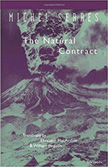 |
Michel Serres. The Natural Contract. Originally published in French in 1990. Ann Arbor, MI: University of Michigan Press, 1995.
While the iron curtain and the Soviet Union came tumbling down, Michel Serres looked elsewhere. In the very first pages of his essay The Natural Contract, first published in 1990, the French thinker plunges himself into an old painting by Francisco Goya. In Fight with Cudgels, we see two giant duelists fighting knee-deep in a swamp: “With every move they make, a slimy hole swallows them up, so that they are gradually burying themselves together. How quickly depends on how aggressive they are: the more heated the struggle, the more violent their movements become and the faster they sink in. The belligerents don’t notice the abyss they’re rushing into; from outside, however, we see it clearly.” While most people were celebrating the triumph of liberal democracy and progress, Serres probed our troubled relation to nature and the ecological crisis, which the Cold War overshadowed. In The Natural Contract, Serres conjures up a series of captivating images at the crossroads of poetry and philosophy.
|